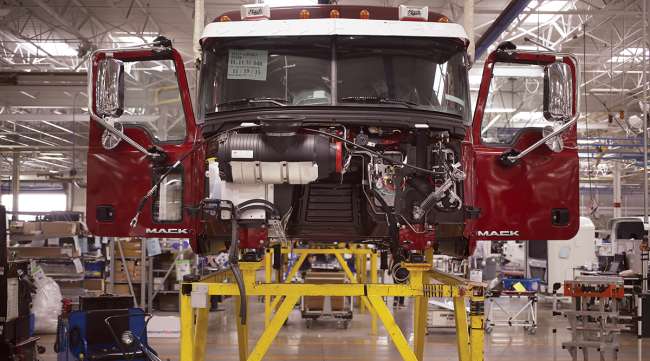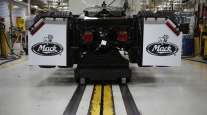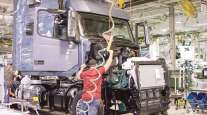Senior Reporter
November Class 8 Orders Stay Strong

[Stay on top of transportation news: Get TTNews in your inbox.]
North American Class 8 orders in November hit 33,000, far above the replacement level of 20,000 per month, but slipped compared with the past two strong months, ACT Research reported, citing truck makers’ preliminary data.
A year earlier, orders plummeted to 9,902 as the industry faced what ACT called an everything shortage. That was the lowest November total since 1995 when orders were 7,923. The all-time low for November was set in 1982 when orders were 5,462.
This November’s orders are yet another indication of fleets’ pent-up demand, and strong carrier profitability and elevated fleet age, according to ACT.
“But the propensity of truck makers to accept orders is declining because the build slots are filling up. Bottom line,” said ACT Vice President Steve Tam.
Net orders were 42,359 in October and an all-time record of 53,271 in September, according to ACT.

Tam
Tam said the backlog is a 12-month rolling window and these November orders will be slotted in, most likely, in fourth quarter of 2023 since there are not many slots left in the third quarter of next year.
ACT’s North American Class 8 production forecast for 2022 is 310,800, up 17.5% from 2021’s 264,470. Its current 2023 forecast calls for a softening of 4.7%, to 296,200, Tam said.
The main question is what is going to happen with the broader economy and with freight. ACT continues to expect a freight recession, and an eventual mild-to-medium economic recession.
“We think by the time we get into the second half of 2023, we are not going to see order activity at above replacement levels,” Tam said. “We still see an industry beset by supply challenges, by the pricing environment for all the inputs into a truck — what truck makers have to pay to manufacture a truck. And then of course, there is the labor environment.”
Every manufacturer and supplier ACT talks with, he said, is having challenges staffing their assembly lines or production lines.
This despite total nonfarm payroll employment increasing by 263,000 in November and the unemployment rate remaining unchanged at 3.7%, the U.S. Bureau of Labor Statistics reported recently. Manufacturing employment has averaged 34,000 per month thus far this year, “little different” from the 2021 average of 30,000 per month.
FTR pegged net orders at 34,300, and reported Class 8 orders now total 295,000 for the last 12 months.

Starks
Jonathan Starks, FTR’s CEO, said, “The market remains strong despite the economic uncertainties, and production still will be limited to some extent by supply chains and labor.”
In related news, Tesla Dec. 1 unveiled its first production model of its battery-electric Tesla Semi for PepsiCo.
Tesla said it expected to produce 50,000 annually by 2024. All would use Tesla-made parts and components exclusively, including chargers.
There was no mention of how many reservations Tesla has for its Semi, but reaction to the announcement led some to suggest fleets would want to use the truck in a pilot before committing to a substantial order. Other unknowns include how the battery-laden Semi — initially introduced in 2017 — would react in an accident, and no metrics are yet available for residual value.
There also was no mention during the livestream announcement of what presenters said was its 80,000-pound GVWR Semi’s cargo capacity compared with a diesel truck.
Typically there is an additional 2,000-pound allowance on the power unit for BEVs and those using natural gas.
The American Transportation Research Institute in its recently released study that assessed the infrastructure requirements for converting the U.S. vehicle fleet — with an emphasis on trucking — to battery-electric addressed the cargo differential.
An ATRI graphic showed if an electric tractor weighs 32,016 pounds compared with 18,216 for a tractor with an internal combustion engine, and both use a trailer weighing 11,264 pounds, the available revenue weight for a BEV is 36,720 pounds compared with 50,520 for an ICE Class 8 — a difference of 13,800 pounds.
Less cargo results in lost revenue, ATRI noted.
In longhaul, that could be a big hurdle.
PepsiCo’s FritoLay division delivered chips and other snack food to the Tesla event from a plant in California using a Semi.
Want more news? Listen to today's daily briefing above or go here for more info
PepsiCo Inc. ranks No. 1 on the Transport Topics Top 100 list of the largest private carriers in North America.
Fleet Advantage, a Class 8 fleet data analytics, equipment financing and life cycle cost management company, announced recently it is placing orders for 200 EV Class 8 tractors for deliveries commencing in calendar year 2023.
The Fort Lauderdale, Fla.-based company noted this will be its first major purchase of alternative energy trucks that will be placed in service based on duty cycles and supply chain locations with reduced radius operations.
It reported it has 14,000 trucks under management.




